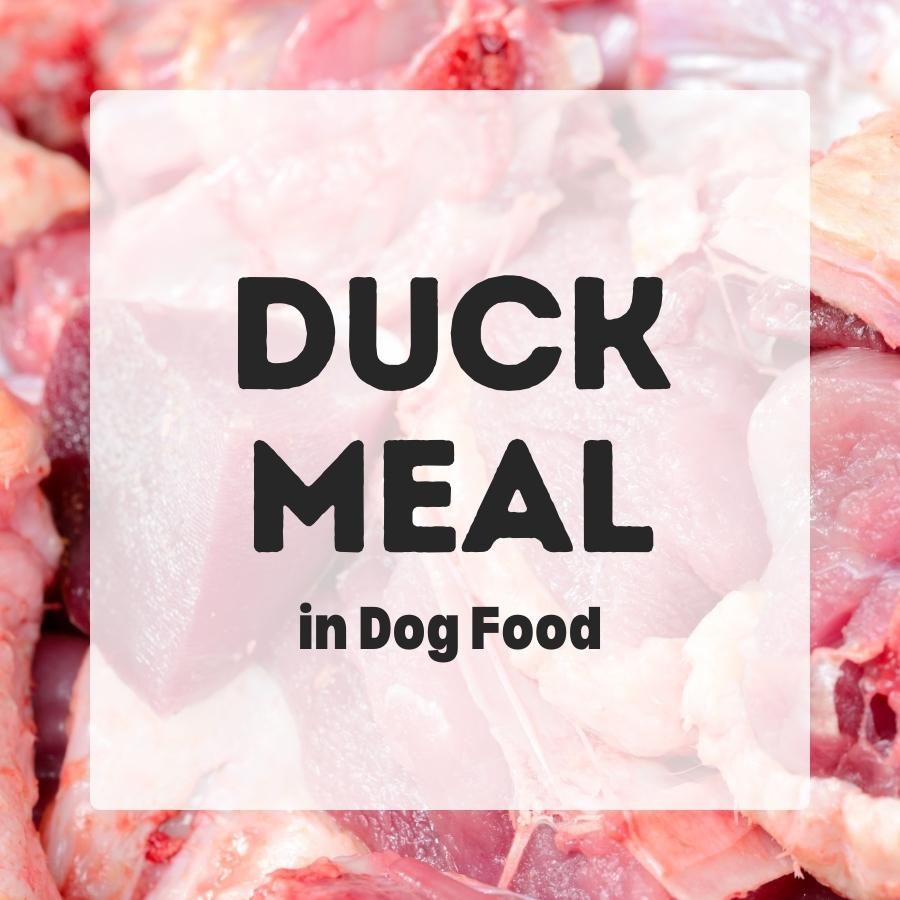Duck meal is not a common ingredient in dog foods. We’ll explain to you what it is and how it’s made.
Contents
What is Duck Meal?
Duck is a novel protein for many dogs but found only in a few commercial dog foods.
By volume, duck meal is not in the top 40 animal protein ingredients used in pet foods[2]. And according to the rendering industry, as of 2006 no one even produced duck meal[4].
All in all, duck meal is a rarely used ingredient.
It is produced by using a rendering process to transform duck tissues into a nutrient-dense powder.
About 30% of the live weight of ducks is not used for human food[5]. So there are plenty of slaughterhouse leftovers that can go into duck meal production.
This includes meat scraps and skin with or without bones or parts or whole duck carcasses but without feathers.
If the raw materials also include heads, feet, viscera (necks, undeveloped eggs, organ meats), or carcasses that have died from other means than slaughter, it would make it a duck by-product meal[1].
During rendering, the duck tissues are ground, heated to high temperatures, and pressed to remove moisture and fat, resulting in a nutrient-dense protein and mineral powder.
The separated fat can be collected and turned into duck fat found in a very small number of dog foods. Finished meals are often stabilized with antioxidants.
Duck Meal Nutrients
Duck with skin can be a fatty ingredient, but duck meal produced for pet food gets partially defatted during rendering.
This leaves a nutrient powder mainly rich in protein (about 70%) with some minerals (about 11-14%).
Dog food manufacturers typically choose pet food-grade meals higher in protein and lower in ash which are better suited for dog nutrition compared to regular livestock feed-grade meals.
In general, duck is considered a complete protein, containing all of the amino acids essential for dogs. It mainly provides saturated and monounsaturated fats and a good amount omega-6 fatty acids.
What we know from similar ingredients like chicken meal is that rendered meals can be less digestible compared to processed ingredients. The same likely applies to duck meal.
But after all, this is a novel and rarely used ingredient in dog foods. So there is not all that much information available on the composition or quality of duck meal.
Duck Meal in Dog Foods
Duck has been gaining popularity over the years but is still an uncommon ingredient mostly used in novel protein diets.
It is a value-added ingredient recycled from duck by-products and offers lots of nutritional value for dog food manufacturers.
Duck meal is made by cooking duck meat, then separating the fat, removing the water content, and grinding it into a fine powder.
This powder is rich in protein and has a low moisture content, making it an ideal ingredient for dry dog food.
One of the advantages of using duck meal in dog food is that it is a named ingredient. Contrary to popular belief, named meals are not immediately of higher quality. But they do provide a little more transparency about what goes into our dogs’ food.
Unlike fresh duck, duck meal is a highly concentrated source of protein. This means that only a small amount of duck meal is required to provide the same nutritional value as a much larger quantity of fresh duck.
When fresh duck meat is used as the primary ingredient in dog food, the high moisture content of raw meat can result in a lower percentage of actual protein in the final product.
This is because most of the weight of fresh meat is water, which is boiled off during kibble manufacturing.
In contrast, duck meal has already been dried and processed, resulting in a much higher protein content per weight than fresh duck.
Moreover, duck meal is more cost-effective than using whole duck meat in dog food. Since duck meal is made from by-products, it can be produced at a lower cost than fresh duck meat. This makes it a more affordable option for pet food manufacturers.
Duck meal is also more stable, transportable, and easier to store than fresh duck meat. This makes it a more convenient and practical ingredient for dog food manufacturers.
In summary, duck meal offers a source of concentrated protein and can help keep the cost of dog food down while still providing the benefits of animal protein.
We recommend looking for a food that does not solely rely on duck meal as its only source of protein since there is so little information to be found about the quality of duck meal in dog food.
But when combined with other high-quality ingredients, duck meal can provide a great source of animal-based proteins, minerals, fats and other nutrients.
Further Reading
[1] AAFCO Official Publication. Chapter 6. Free Access.
[2] Pet Food Production and Ingredient Analysis (PDF). 2020. Institute for Feed Education and Research (IFEEDER), North American Renderers Association (NARA), Pet Food Institute (PFI)
[3] Deng et al. Chemical composition, true nutrient digestibility, and true metabolizable energy of novel pet food protein sources using the precision-fed cecectomized rooster assay. Journal of Animal Science. 2016. https://doi.org/10.2527/jas.2016-0473
[4] Aldrich: Rendered Products in Pet Food. Published in Essential Rendering (pdf). 2006.
[5] David L. Meeker, Ph.D., MBA: Old is New—Rendering Utilizes all By-Products from the Meat Industry (pdf).
